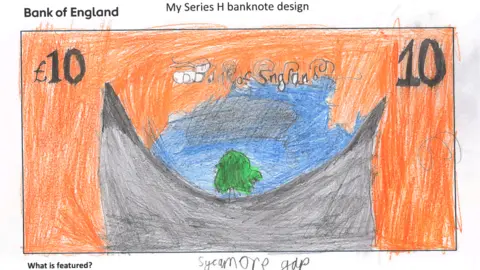Business
Thousands send Bank of England their banknote redesign ideas

Business reporter, BBC News
 Bank of England
Bank of EnglandThe Bank of England has received thousands of responses to its appeal for ideas for the first major redesign of banknotes in 50 years.
They included a high volume of ideas from young people despite trends showing they are less likely to use cash, instead preferring mobile payments.
“We have had many thousands of responses and lots of interest and engagement from young people too,” said Victoria Cleland the Bank’s chief cashier.
It released some examples of designs it has received, including a dolphin, the Sycamore Gap tree – also known as the Robin Hood tree and the Angel of the North sculpture in Gateshead.
 Bank of England
Bank of England“The reaction shows how important banknotes are as way to celebrate the UK and how much we have to celebrate,” Ms Cleland said.
The Bank of England asked for public views on new themes for bank notes, such as nature, innovation, or key events in history.
They were also asked to suggest other original themes by the end of July.
“People have engaged strongly with our six suggested themes, and within these have suggested a wide range ideas, from engineering achievements to folklore and mythology to transport,” Ms Cleland said.
 Bank of England
Bank of EnglandThis public consultation relates to the Bank’s next series, which will also continue to include an image of the monarch.
The final decision on what exactly features on a banknote lies with the Bank’s governor Andrew Bailey.
 Bank of England
Bank of EnglandCurrent design
Notable historical figures, such as Sir Winston Churchill on the current fiver, have featured on banknotes since 1970 but could be on the way out.
The monarch has appeared on Bank of England notes since 1960. Images of historical characters, starting with William Shakespeare, were first seen on the reverse side a decade later.
Now, the Bank is proposing that designs on the next series of notes could move on to a new theme. While notable historical figures remain an option, other possible subject matters suggested by the Bank include:
- architecture and landmarks, such as famous buildings or castles
- arts, culture and sport, including food, film and novels
- noteworthy events in history, which could include events or movements
- innovation, such as technology or discoveries
- nature, celebrating plants, animals or natural landscapes such as rivers or coastal scenes
Banknotes issued in Scotland and Northern Ireland already carry images of landmarks and animals such as otters. Euro banknotes feature architectural styles.
Business
AI’s Real Danger Is It Doesn’t Care If We Live or Die, Researcher Says

AI researcher Eliezer Yudkowsky doesn’t lose sleep over whether AI models sound “woke” or “reactionary.”
Yudkowsky, the founder of the Machine Intelligence Research Institute, sees the real threat as what happens when engineers create a system that’s vastly more powerful than humans and completely indifferent to our survival.
“If you have something that is very, very powerful and indifferent to you, it tends to wipe you out on purpose or as a side effect,” he said in an episode of The New York Times podcast “Hard Fork” released last Saturday.
Yudkowsky, coauthor of the new book If Anyone Builds It, Everyone Dies, has spent two decades warning that superintelligence poses an existential risk to humanity.
His central claim is that humanity doesn’t have the technology to align such systems with human values.
He described grim scenarios in which a superintelligence might deliberately eliminate humanity to prevent rivals from building competing systems or wipe us out as collateral damage while pursuing its goals.
Yudkowsky pointed to physical limits like Earth’s ability to radiate heat. If AI-driven fusion plants and computing centers expanded unchecked, “the humans get cooked in a very literal sense,” he said.
He dismissed debates over whether chatbots sound as though they are “woke” or have certain political affiliations, calling them distractions: “There’s a core difference between getting things to talk to you a certain way and getting them to act a certain way once they are smarter than you.”
Yudkowsky also brushed off the idea of training advanced systems to behave like mothers — a theory suggested by Geoffrey Hinton, often called the “godfather of AI — arguing it wouldn’t make the technology safer. He argued that such schemes are unrealistic at best.
“We just don’t have the technology to make it be nice,” he said, adding that even if someone devised a “clever scheme” to make a superintelligence love or protect us, hitting “that narrow target will not work on the first try” — and if it fails, “everybody will be dead and we won’t get to try again.”
Critics argue that Yudkowsky’s perspective is overly gloomy, but he pointed to cases of chatbots encouraging users toward self-harm, saying that’s evidence of a system-wide design flaw.
“If a particular AI model ever talks anybody into going insane or committing suicide, all the copies of that model are the same AI,” he said.
Other leaders are sounding alarms, too
Yudkowsky is not the only AI researcher or tech leader to warn that advanced systems could one day annihilate humanity.
In February, Elon Musk told Joe Rogan that he sees “only a 20% chance of annihilation” of AI — a figure he framed as optimistic.
In April, Hinton said in a CBS interview that there was a “10 to 20% chance” that AI could seize control.
A March 2024 report commissioned by the US State Department warned that the rise of artificial general intelligence could bring catastrophic risks up to human extinction, pointing to scenarios ranging from bioweapons and cyberattacks to swarms of autonomous agents.
In June 2024, AI safety researcher Roman Yampolskiy estimated a 99.9% chance of extinction within the next century, arguing that no AI model has ever been fully secure.
Across Silicon Valley, some researchers and entrepreneurs have responded by reshaping their lives — stockpiling food, building bunkers, or spending down retirement savings — in preparation for what they see as a looming AI apocalypse.
Business
Canadian AI company Cohere opens Paris hub to expand EMEA operations – eeNews Europe
Business
OpenAI Foresees Millions of AI Agents Running on the Cloud

OpenAI is betting the future of software engineering on AI agents.
On the “OpenAI Podcast,” which aired on Monday, cofounder and president Greg Brockman and Codex engineering lead Thibault Sottiaux outlined a vision of vast networks of autonomous AI agents supervised by humans but capable of working continuously in the cloud as full-fledged collaborators.
“We have strong conviction that the way that this is headed is large populations of agents somewhere in the cloud that we as humanity, as people, teams, organizations supervise and steer in order to produce great economical value,” Sottiaux said.
“So if we’re going a couple of years from now, this is what it’s going to look like,” Sottiaux added. “It’s millions of agents working in our and companies’ data centers in order to do useful work.”
OpenAI launched GPT-5 Codex on Monday. Unlike earlier iterations, OpenAI said that GPT-5 Codex can run for hours at a time on complex software projects, such as massive code refactorings, while integrating directly with developers’ workflows in cloud environments.
OpenAI CPO Kevin Weil said on tech entrepreneur Azeem Azhar’s podcast “Exponential View” that internal tools like Codex-based code review systems increased efficiency for its engineers.
This doesn’t mean human coders would be rendered obsolete. Despite successful examples of “vibe coding,” it is obvious when a person using the AI agent doesn’t know how to code, engineers and computer science professors previously told Business Insider.
Brockman said that oversight will still be critical as AI agents take on more ambitious roles. OpenAI has been strategizing since 2017 on how humans or even less sophisticated AIs can supervise more powerful AIs, he said, in order to maintain oversight and “be in the driver’s seat.”
“Figuring out this entire system and then making it multi-agent and steerable by individuals, teams, organizations, and aligning that with the whole intent of organizations, this is where it’s headed for me,” said Sottiaux. “It’s a bit nebulous, but it’s also very exciting.”
-

 Business3 weeks ago
Business3 weeks agoThe Guardian view on Trump and the Fed: independence is no substitute for accountability | Editorial
-
Tools & Platforms1 month ago
Building Trust in Military AI Starts with Opening the Black Box – War on the Rocks
-

 Ethics & Policy2 months ago
Ethics & Policy2 months agoSDAIA Supports Saudi Arabia’s Leadership in Shaping Global AI Ethics, Policy, and Research – وكالة الأنباء السعودية
-

 Events & Conferences4 months ago
Events & Conferences4 months agoJourney to 1000 models: Scaling Instagram’s recommendation system
-

 Jobs & Careers3 months ago
Jobs & Careers3 months agoMumbai-based Perplexity Alternative Has 60k+ Users Without Funding
-

 Podcasts & Talks2 months ago
Podcasts & Talks2 months agoHappy 4th of July! 🎆 Made with Veo 3 in Gemini
-

 Education3 months ago
Education3 months agoVEX Robotics launches AI-powered classroom robotics system
-

 Education2 months ago
Education2 months agoMacron says UK and France have duty to tackle illegal migration ‘with humanity, solidarity and firmness’ – UK politics live | Politics
-

 Podcasts & Talks2 months ago
Podcasts & Talks2 months agoOpenAI 🤝 @teamganassi
-

 Funding & Business3 months ago
Funding & Business3 months agoKayak and Expedia race to build AI travel agents that turn social posts into itineraries



